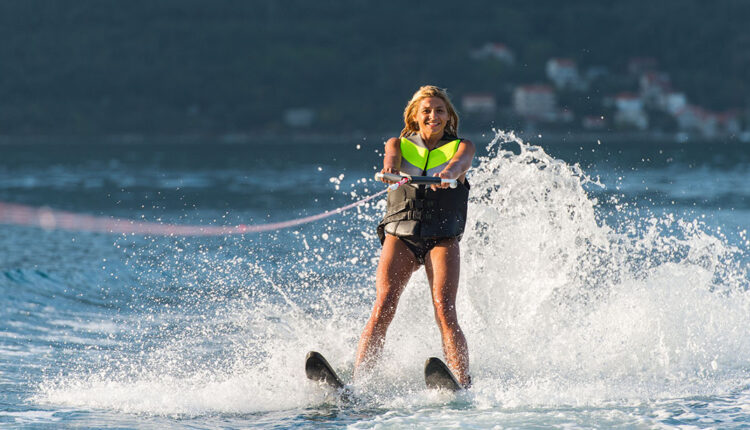Water skiing is the ultimate summertime sport. The adrenaline rush of gliding on top of the water as a boat filled with your closest friends and family cheer you on (even when you fall in) is what keeps people coming back for more.
The thrill and feeling of self-accomplishment (along with a full-body workout) that water skiing provides is one of the many reasons people look to strengthen their skills, after all, the better you are at the sport, the less time you spend falling into the water while more time is spent feeling on top of the world.
For beginners and summertime skiers looking to sharpen their water-skiing skillset, Jac Lyman, lifelong show skier and owner of Flyman Sports who skis professionally around the world earning a national championship and three world championships in show skiing, provides her top tips to take your waterskiing experience to the next level.
Water Skiing Has No Age Limit
From young kids to senior citizens, all can experience the fun water skiing provides, as well as every member of your family. “Water skiing is the ultimate family sport,” says Lyman.
If your family or group of friends joins a ski team, every member can get involved, and all can enjoy the ultimate water-skiing experience.
“Instead of dropping your kids off for soccer practice and sitting on the sidelines, whole families grow and learn together every weekend in the sport,” she says and explains that water skiing is one of the only activities in the world where teenagers will choose to spend the entire weekend with their parents (and maybe even party together after).
“Water skiing has no age limit—there are itty bitty skiers who can’t read yet and little old ladies in flowered swim caps who are learning the sport,” Lyman shares.
So, if you’re having doubts that you’re too old or not in shape enough to water ski, let those doubts fall into the water as you soak up these tips!
Here’s What You’ll Need to Water Ski
When it comes to water skiing equipment, what you’ll need depends on what discipline you are learning. There are nine recognized divisions in the sport of water skiing: Show Skiing, 3 Event, Barefoot, Hydrofoil, Wakeboard, Collegiate, Kneeboard, Racing, and Adaptive Skiing (for skiers with disabilities.)
However, for any, Lyman explains you’ll need:
- A personal floatation
- A boat (driver/rider)
- A rope
- Ski or skis (Except for barefooting)
Something to keep in mind: The differences in the divisions are much like the differences in snow sports; each discipline utilizes specialized equipment for both safety and performance.
How to Water Ski: Tips and Instructions for The Best Water-Skiing Experience
Lyman’s three tips for a strong start:
- 1. Start with a knowledgeable instructor: Not only can a good coach help you learn faster, but qualified coaches are trained in best practices that will keep you safe in the unpredictable environment of a natural waterway.
- Safety Check Your Equipment: Check to make sure your vest and ski fit properly and that your equipment is safe and connected.
- Focus on Relaxing Once You Enter the Water: There’s no sense in wasting all of your energy flailing about in the water, you’re going to need every ounce of muscle for the skiing part.
Follow These Instructions When in the Water
- Face the same direction as the boat.
- put the rope between your skis, and wait for the boat to pull the rope tight and gently drag you just in gear.
- Use this time dragging to get comfortable resisting the push of the boat and practice steering with your legs.
- Once you’ve mastered body control with the boat just in gear, give your boat driver a loud verbal signal that you are ready to go.
- Keep your arms mostly straight and your ski tips above water, as the boat reaches speed, push against the water with your legs and keep your handle low and in front of you.
- Once you and the boat reach a plane, push your hips forward to stand up straight and tall and lean back against the rope – ta-da – that’s water skiing!
Pro Tip yo Stay Afloat
“You’ll always hear water ski instructors use the old phrase “let the boat pull you” – and even though it may not make sense to virgin water ski ears, it’s true,” says Lyman. “What this means is that the boat is doing the work here, so if you try to pull your arms in to pull yourself up, you will indeed fall.”
PRO TIP: Keep your arms mostly straight (a loose bend is fine) and let your legs do all of the work!
Learn the Etiquette of the Sport—and Keep Practicing It
“Don’t be “that guy,” Lyman stresses and encourages, for whatever waterway you are using, to learn the etiquette and rules of the water. “Some lakes will have a certain direction you must go, most places require that you stay a certain distance from docks, boats, and structures; and some places may have times where you are not allowed to go at speed.” She explains.
Overall, keep a safe distance from other boaters, give leeway to other skiers using the space, and treat others on the water the way you would like to be treated. This way, it’s a great day for everybody.
Follow These Rules Water Skiing Safety
- Use a Personal Flotation Device: Even if your jurisdiction doesn’t require it, it’s always best practice to use a personal floatation device and a spotter in the boat. “Both can save your life in an emergency and in the water; you can’t afford to waste any time,” says Lyman.
- Bring A Cell Phone with a Working Battery: Lyman recommends you always make sure someone in the boat has a working cell phone with a full battery in case of an emergency.
- Learn How to Trick Release: If you are doing any kind of skiing where your hands are not holding onto the rope, Lyman stresses the importance of using a trick release that will release the skier from the boat in case of a fall.
- Ride with Only A Qualified Driver: Make sure your driver is fully qualified to operate the vessel and knows all of the rules of the water.
Water skiing is a lifetime of opportunity that can keep your family active together or take you around the world.
To find a ski team near you, just go to USAWaterSki.org and get involved!


Comments are closed.